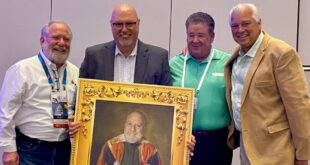Over the last few months, there have been several technical committee meetings for standards that our members use or will use every day. In just one week, AFSA participated in a pre-first draft meeting for the 2027 edition of NFPA 88A, Standard for Parking Structures, a second draft meeting for the 2025 edition of NFPA 20, Standard for the Installation of Stationary Pumps for Fire Protection, a first draft meeting for the 2026 edition of NFPA 770, Standard on Hybrid (Water and Inert Gas) Fire-Extinguishing Systems, and the inaugural first draft meeting for the proposed NFPA 200, Standard for Hanging and Bracing of Fire Suppression Systems. And, if that wasn’t enough, NFPA 25, Standard for the Inspection, Testing, and Maintenance of Water-Based Fire Protection Systems, held its first draft meeting for the 2026 edition.
Throughout my career, I have learned the most during technical committee meetings. This is where new ideas and new technologies are first introduced, arguments are made to justify support or opposition to proposed changes, positions change based on the merits of those arguments, and the true intent of requirements is hashed out. Technical committee meetings provide a different perspective, and due to the open nature of the NFPA standards development process, I would encourage all who are able to attend and listen to the discussion.
While it was a hectic couple of weeks, AFSA staff represented our membership in every technical meeting. Through the review of the public inputs and public comments, as well as the discussions during the meetings, here are the key takeaways from each meeting:
NFPA 88A – There is no prescriptive approach for parking structure hazard classification … yet.
Everyone wants parking structures to fit into a perfect cookie-cutter mold for hazard classification, but there are a lot of unanswered questions about having a one-size-fits-all approach. Are there going to be electric vehicles present? If so, will there be charging stations? Is the parking structure self-parking, valet parking, or automated? Each choice will change the fire risk in the structure and really should be considered by a responsible design professional. Be on the lookout for the phase two report from the Fire Protection Research Foundation, which should answer some of these questions.
NFPA 20 – Fire pump motors are oversized, and the requirement incentivize inefficient design, but no one knows why.
NFPA 20 requires that motors provide the required power to operate the pump at any flow condition—even though NFPA 20 also limits the available flow for design to 150 percent capacity. There are public inputs and public comments over the last few cycles to reduce the power requirements on fire pump motors, but the proposals have been rejected each time with little or no technical substantiation. Stay tuned for possible actions that will take place at the 2024 Technical Meeting to address this issue.
NFPA 770 – See manufacturer’s instructions.
Hybrid systems are still relatively new to the industry, and to be accepted internationally, an installation standard was needed. If you read the document closely, the majority of the requirements for system design and installation still rely heavily on the listing and the manufacturer’s instructions.
NFPA 200 – Does this document really need to cover all hanging and bracing requirements for water-based systems?
Prior to the establishment of the NFPA 200 technical committee, each individual water-based fire protection system was left to its own devices to develop hanging and bracing requirements. NFPA 13, Standard for the Installation of Sprinkler Systems, has its own hanging and bracing committee and derived specific hanging requirements from established industry standards and simplified seismic design for sprinkler systems based on ASCE 7, Minimum Design Loads and Associated Criteria for Buildings and Other Structures. For most of the other systems, the committees punted and simply stated, “hang and brace in accordance with NFPA 13,” and NFPA 200 is needed to prescribe appropriate requirements for those systems. But what about NFPA 20 and NFPA 22, Standard for Water Tanks for Private Fire Protection, which already have fully developed requirements? Does NFPA 200 really need to extract those requirements just to have them extracted back into their originating document? This is something to discuss and consider for the public comment phase.
NFPA 25 – Can the AHJ really do whatever they want?
One of my least favorite tropes said during meetings is, “The AHJ can do whatever they want.” This is not 100 percent true. AHJs (Authorities Having Jurisdiction) play a vital role in the fire protection ecosystem and are the last line of defense to make sure that the requirements in codes and standards are being applied correctly, but the AHJ does not have free reign to “do whatever they want.” Code enforcement is just that—enforcing the minimum codes and standards (plus any local amendments that go through the legislative process). I think there is a misconception that the equivalency section in Chapter 1 provides the AHJ absolute power, but equivalency should be documented and substantiated to the AHJ so that they can make the final call.
There is no end to the changes occurring in our codes and standards as technologies, means, and methods continue to evolve. The standard development process continues with each new edition. AFSA looks forward to 2024, when we will reestablish the Technical Advisory Council to get our members more involved in the NFPA standards development process and shape the development of the codes and standards so that they benefit our membership base.
ABOUT THE AUTHOR:

Kevin Hall, M.Eng., P.E., ET, CWBSP, PMSFPE, is the senior manager of engineering and technical services for the American Fire Sprinkler Association (AFSA). He is a member of several National Fire Protection Association (NFPA) technical committees responsible for developing the model codes and standards, including, NFPA 1 Fire Code, NFPA 13/13R/13D Installation of Sprinkler Systems, NFPA 20 Installation of Stationary Fire Pumps for Fire Protection, NFPA 30 Flammable and Combustible Liquids Code, and NFPA 915 Remote Inspections. He also represents AFSA on numerous UL standard technical panels responsible for revising and maintaining the product standards used in the sprinkler industry. He is a registered professional engineer in Delaware and Maryland, NICET III certified in water-based system layout, a certified water-based system professional through NFPA, and a professional member of the Society of Fire Protection Engineers (SFPE). He earned his Bachelor of Science and Master of Engineering degrees from the University of Maryland College Park in fire protection engineering. In 2021, he was recognized as one of SFPE’s “5 Under 35” award recipients. Prior to his association and committee work, he worked for Reliance Fire Protection in Baltimore, Maryland as a project manager overseeing projects of various sizes and complexity for the Contracts Division.
 Sprinkler Age A Publication of the American Fire Sprinkler Association
Sprinkler Age A Publication of the American Fire Sprinkler Association

